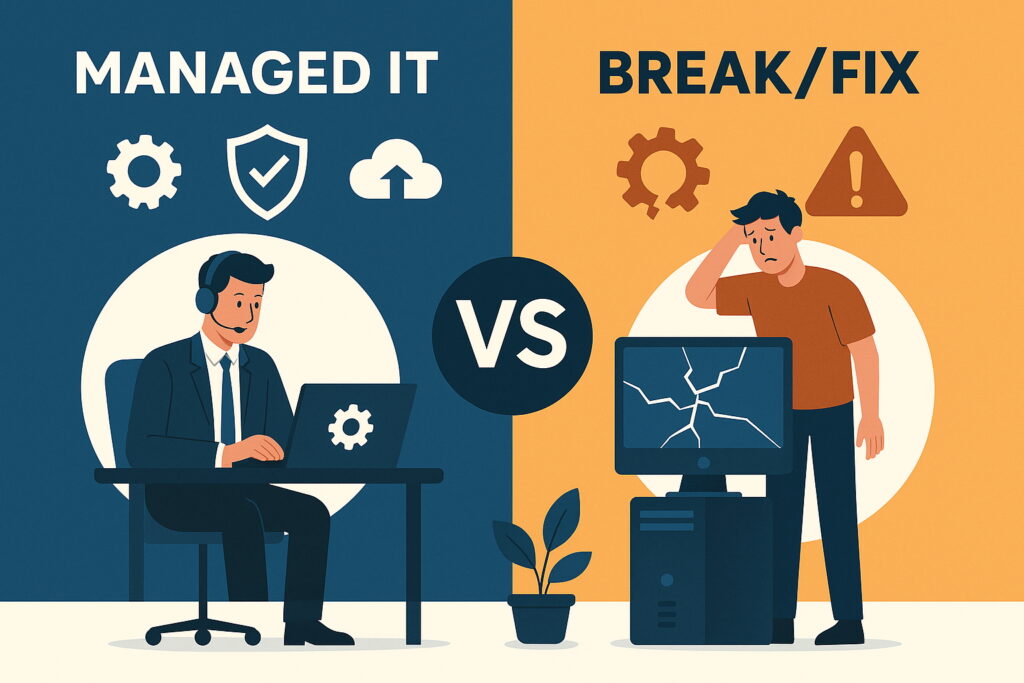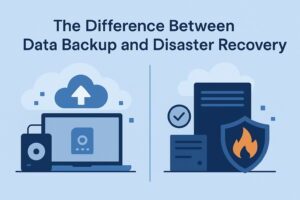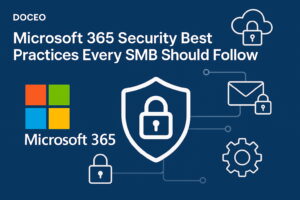Managed IT vs. Break/Fix: What’s Better for Growing Businesses?

What Is the Difference Between Managed IT and Break/Fix Services?
At its core, the break/fix model is reactive. Something breaks — a server crashes, a printer won’t connect, your email goes down — and you call a technician to fix it. You pay for time and materials, and when the issue is resolved, that’s the end of the transaction, illustrating the differences in managed IT vs break scenarios.
Managed IT services, on the other hand, are proactive. Instead of waiting for something to go wrong, you pay a flat monthly fee for continuous monitoring, maintenance, and support. Managed IT includes things like network monitoring, cybersecurity, help desk support, patch management, and even strategic IT planning.
Why Growing Businesses Should Think Beyond Break/Fix
As your business grows, so does your reliance on technology. That means downtime, security breaches, or outdated systems can cause serious disruption. Here are five key reasons why many growing businesses outgrow the break/fix model: in this context, understanding managed IT vs. break potential is crucial.
1. Unpredictable Costs
With break/fix, IT expenses fluctuate wildly. One month may be quiet, while the next may bring a costly server repair. Managed IT provides cost predictability with a consistent monthly investment, which is easier to budget and plan around. Compare managed IT vs break’s unpredictable nature.
2. Longer Downtime
Break/fix doesn’t usually involve active monitoring. So when systems fail, they may be down for hours (or longer) before anyone even notices. Managed IT providers detect issues in real-time and often fix them before they impact productivity, unlike the break/fix model connected with managed IT vs. break situations.
3. No Strategic IT Guidance
Break/fix technicians solve problems but typically don’t offer guidance on infrastructure, scaling, or cybersecurity. A managed IT partner helps plan upgrades, recommends solutions tailored to your growth, and aligns IT with your business goals. Here, analyzing managed IT vs break guidance becomes important.
4. Greater Risk Exposure
In the break/fix model, software patches, backups, and updates often fall through the cracks. That leaves your network vulnerable to cyberattacks, data loss, and compliance failures. Managed IT continuously maintains and secures your systems. Therefore, evaluate managed IT vs break risk exposures.
5. Lack of Accountability
Break/fix providers are incentivized to fix problems when they occur, not to prevent them. Managed IT providers are accountable for uptime, performance, and security because their model relies on preventing issues from happening in the first place, unlike break/fix, which is a stark contrast in managed IT vs. break settings.
Consider a Hypothetical Scenario
Let’s say a growing accounting firm has 20 employees. They rely heavily on cloud apps, shared storage, and a multifunction printer for daily operations, illustrating managed IT vs break adaptations.
One Monday morning, their internet goes down. The firm calls their break/fix provider, but the technician is booked until Tuesday. That’s a full day of missed work for 20 people. Worse, it turns out the router failed because it hadn’t received a critical firmware update—something a managed IT provider would have caught in advance.
That one incident cost the firm over $5,000 in lost productivity, not including the repair fee, showcasing managed IT vs break outcomes.
How Managed IT Aligns with Business Growth
Managed IT isn’t just about fixing things faster—it’s about growing smarter. Here’s how it directly supports scaling businesses, comparing managed IT vs break principles:
- Scalability: Easily add new users, devices, or locations without starting from scratch.
- Security: Managed firewalls, antivirus, and endpoint protection to keep threats at bay.
- Compliance: Guidance on meeting HIPAA, PCI, or other industry regulations.
- Productivity: Faster support and reduced downtime mean your team stays focused on work.
- Budgeting: Predictable costs and reduced emergency spend.
Managed IT Isn’t Just for the Enterprise
A common myth is that only large enterprises need managed IT. In reality, small and mid-sized businesses benefit the most. That’s because they often lack in-house IT staff and face even greater risks from downtime and cyber threats, unlike break/fix, which is part of a managed IT vs break analysis. Managed IT fills that gap affordably.
Is There Ever a Place for Break/Fix?
Yes — for very small businesses (1–2 people) with minimal tech needs, or for one-time projects (like setting up a printer), break/fix might be sufficient. But for businesses with 10+ employees, shared infrastructure, or compliance requirements, it simply isn’t enough. Hence, managed IT vs break’s scope is worth considering.
Doceo’s Approach to Managed IT
At Doceo, we understand that no two businesses are alike. That’s why we tailor managed IT plans to fit your needs, size, and budget. Our proactive support model ensures uptime, secures your network, and scales with you as you grow, illustrating managed IT vs break approaches.
We go beyond generic packages. Our team offers:
- Personalized onboarding and IT roadmap planning
- Continuous security monitoring and patching
- Fast-response help desk and remote support
- Strategic technology recommendations based on your goals
Conclusion: Which One Should You Choose?
If your business is growing and technology plays a role in your day-to-day operations, the answer is clear: managed IT is the smarter, safer, and more strategic choice. While break/fix may work for occasional support, it leaves your business exposed to risk and disruption, emphasizing the differences in managed IT vs. break scenarios.
Tired of IT fires and unpredictable tech costs? Let Doceo show you how managed IT can save money, boost security, and drive growth. Schedule a free consultation today or call 888-757-6626.
Doceo | Proven Technology. Proven People.
Visit us at www.mydoceo.com | Connect with us on LinkedIn




